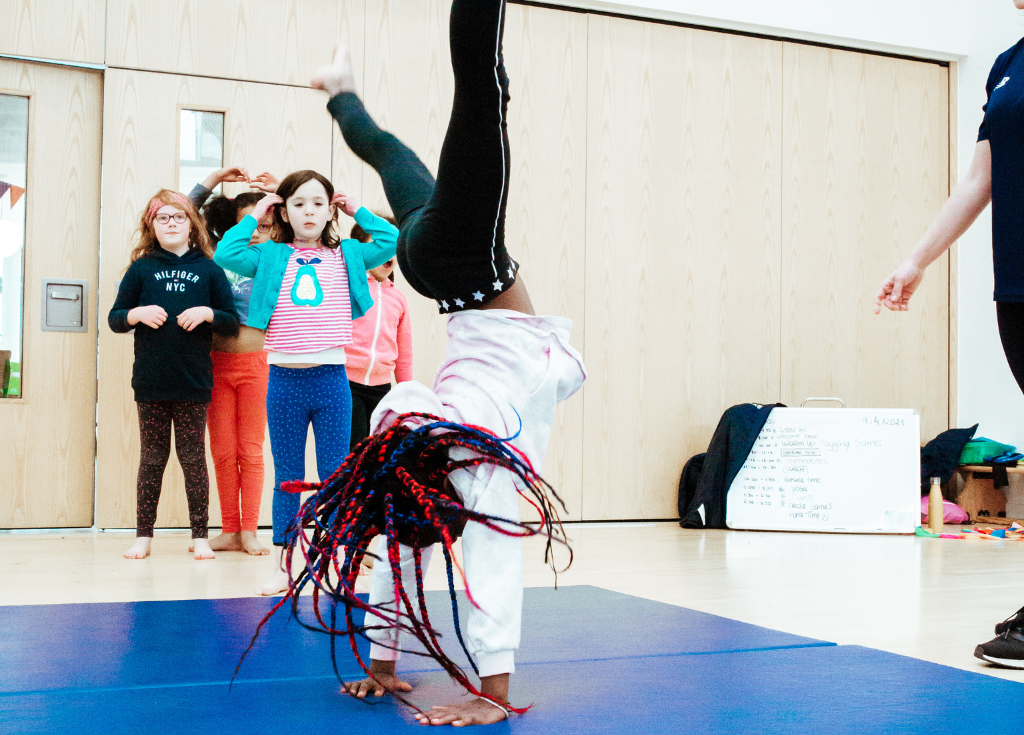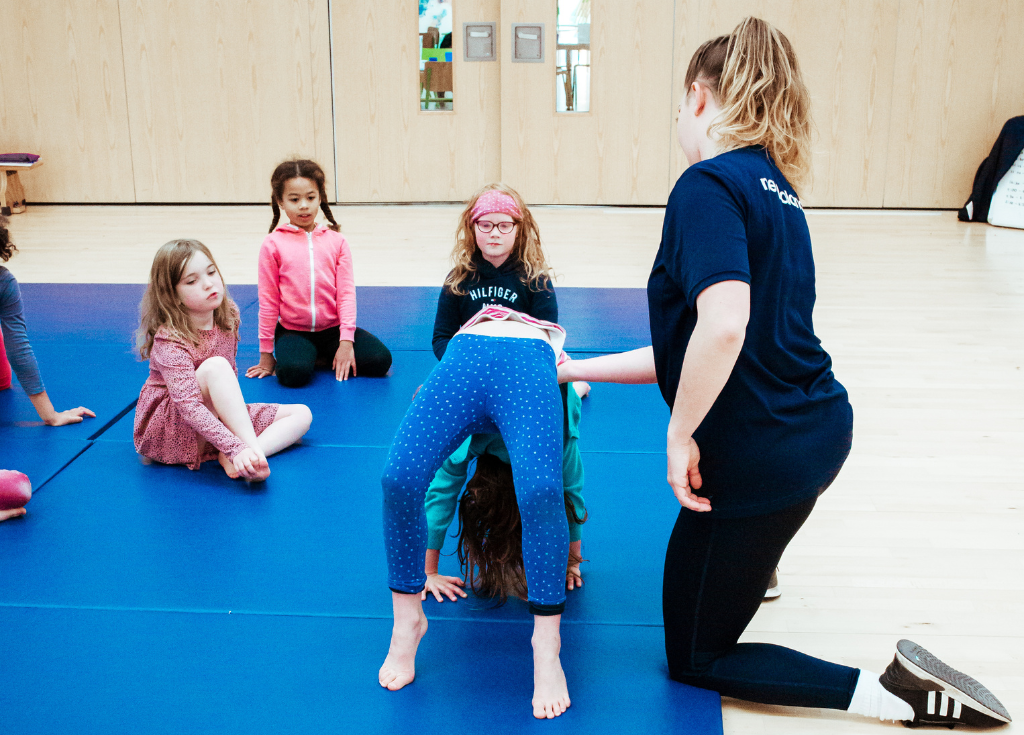7 Basic Gymnastics Skills that will Boost Coordination, Flexibility and Confidence
All professional gymnasts had to start by mastering the basics.
It seems inconceivable when you watch their polished, technical performances. Their elegance, their precision, their explosive power; it seems other-worldly.
Gymnastics, like many sports, requires physical training to perfect the health and function of the body. Skills such as strength, power, endurance, coordination and flexibility form a crucial part of this training.
Rise Gymnastics, a programme developed by British Gymnastics to modernise the delivery of the sport in UK schools, (delivered by us as exclusive schools delivery partner), condenses motor skill development and physical fitness into four key Gymnastics Fundamental Movement Patterns:
- Locomotion
- Balance
- Spring
- Rotation
By developing these movement patterns first and foremost, children can then apply them to develop gymnastics-specific skills.

Intimidating as that it seem, every Olympian started in the same place: you need to walk before you can flip!
Here’s our rundown of the top key skills any budding or aspiring gymnast needs to master.
The 7 basic gymnastics skills
We’ve compiled 7 basic skills every wide-eyed hopeful gymnast should know. While these are basic gymnastics skills, we recommend children only practice with supervision from parents, teachers or coaches.
Backward roll
The backward roll is a forward roll in reverse but is considered more difficult because gymnasts are unable to see where they are going.
Trusting yourself is one of the hardest stumbling blocks in this move; falling backwards goes against the grain. But the backward roll is vital in building the confidence to do this.
The tuck position must be maintained and practise will enable you to work out the correct level of force required to propel through the roll.
The backward roll develops a gymnast’s instinct to tuck and roll safely out of moves if they make a mistake. It’s also the best starting point for developing other moves such as the backward flip, back handspring or backward somersault.
Handstand

An original classic: the handstand is another gymnastic move taken straight from the playground.
The handstand is a deceptively simple basic skill.
Maintaining the rigidity of your body in the handstand position requires exceptional strength. Keeping the legs straight and upright works the core muscles extensively – all of which are needed for every gymnastics discipline going forward.
The best way to learn the handstands is through a step-by-step, progressional approach. A range of drills and techniques will better equip the individual for handstand development. These include elevated feet walks and donkey kicks.
For the more uncertain young gymnasts, a wall can be used as a prop. It helps keep the body position upright and straight, whilst providing support.
Headstand
This is a tricky move to master, especially for beginners. Attempting a headstand if inexperienced could lead to injuries, especially if unsupervised.
The key to the headstand is creating a stable base. Often referred to as a ‘tripod’, it involves forming a base using the crown of the head and the hands. The head rests on the ground and the hands are placed laterally to the head, thus forming a triangle.
From here, press down on the hands (using every part of the hand, including fingertips, for grip) and raise the legs.
Practice a tucked headstand first before mustering the courage to straighten the legs, one at a time. Use a wall or a partner for added support if feeling under-confident.
Headstands are great way to improve balance, increase muscle strength and improve flexibility. It can seem a daunting position to master but practice really makes perfect, so don’t give up!
Cartwheel
Great for coordination and balance, cartwheels are an essential skill for gymnasts. Cartwheels help to strengthen bones such as the spine, shoulders, wrists and arms and form a foundation movement which leads into other more advanced techniques such as a one-handed cartwheel or cartwheeling on a balance beam.
Begin in a lunge position, with the dominant leg forward and slightly bent, and the back leg straight. Arms should be up in the air beside the ears – top tip, try to keep arms glued to the ears throughout the entire cartwheel.
Put hands on the ground with hands turned 90 degrees then kick the feet over the head one at a time. The first foot raised should be the first to land.
The gymnast lands in a lunge position facing the opposite direction they started in.
At first, cartwheels can look a little messy with legs flailing to the sides. As time goes on, aim for straight legs which go higher over the head throughout the cartwheel. Work on good form; neatness and positioning are crucial to mastering this move.
Splits
Rounding out the playground-friendly gymnastics skills is the split position. For boosting flexibility, this is the move hopeful young gymnasts should reach for.
The splits is a physical position which requires both legs to extend in opposite directions. The front split sees the body face forwards with legs extended either side, while the side split is when one leg is extended in front of the torso and the other behind, with the body facing in the direction of the front leg.
The splits work the hamstrings, hip flexors, and a variety of smaller leg muscles. It’s a move that often appears – in other, more complex forms – during floor routines. The splits is one of those beginner gymnastics skills that every young gymnast simply must learn.
For some, the splits will come naturally. Others have to work at it – but repeated attempts loosen the muscles and soon grant the flexibility needed to reach the split position.
For those feeling confident, take it one step further by performing a split leap; a sequence of body movements where a gymnast assumes a split position in the air after leaping from the floor.
Bridge

It may not look like much, but the bridge is one of the building blocks to achieving the shoulder and hip flexor flexibility needed for overhead moves like the back walkover or back handspring.
Gymnasts bend their backs and push off from the floor with their hands by their heads. Once in the bridge position, the trick is to straighten the arms and legs, working towards forming a straight line from the wrists to the shoulders.
The move works to build core muscles, but the greatest effect can be felt in the shoulders. Like the splits, performing a bridge correctly takes patience. It can take quite a few attempts to stretch the muscles out enough to achieve the bridge position so don’t give up and never push beyond what feels comfortable.
Rotating jumps
Jumps require an explosion of power and are excellent for improving co-ordination and balance thanks to its demand on multiple muscle groups and core.
A 360 degree rotating jump requires the body to leap and twist 360 degrees, with the gymnast landing in the same direction as they started.
Start in a standing position with feet hip-width apart. If twisting to the left, the left arm should be forward with the right hand to the side. If twisting to the right, the right arm should be forward with the left hand to the side. This helps with momentum.
Jump and rotate, pulling the feet together as you leave the floor and twist. This will help to form a tight body position, which will improve the speed of the jump.
Complete the full rotation and land with a soft bend in the legs. Use toes to grip the ground as this will support balance.
Elegant jumps can be incorporated into a gymnastic routine or used to change direction (if performing a 180 degree jump). They’re also a relatively easy and accessible skill for children to practice to improve spacial awareness and coordination.
How gymnastics boosts health and physical development
In a study conducted by Loughborough University regarding Gymnastics as a Foundation Sport (March 2016), British Gymnastics sought to examine whether pre-existing academic evidence supported the claim that gymnastics has a unique role as a foundation sport, which provides children with opportunities to develop that are not available in other sports.
The findings summarised 3 areas in which benefits are realised through participation in gymnastics:
Motor skill development: Postural control and motor coordination
Physical fitness: Endurance, strength, power, speed and agility, flexibility, balance
Psycho-social benefits: Spatial aptitude, communication, team work
Other benefits of gymnastics include building a strong physical and mental foundation for children. Taking part in physical activity and living an active life releases endorphins, which boost children’s mood and alleviate feelings of stress.
Since practise and perseverance is fundamental in gymnastics, the sport can help children to learn discipline as well as hone evaluation and judgement-making abilities. It also promotes teamwork and social skills, which can increase confidence.
Get involved
Gymnastics is popular and, since it’s best carried out under the supervision of an experienced trainer, places at gymnastics clubs can be sought-after.
Alternatively, schools keen to offer gymnastics directly to their pupils can introduce a dedicated gymnastics or sport coach who can offer the sport in PE lessons or as extracurricular sessions.
At Premier Education we specialise in delivering physical activity sessions at primary schools where they may want to enhance the sporting provision. Thanks to our partnership with British Gymnastics we are able to offer Rise Gymnastics, a dedicated programme of gymnastics delivery which has been developed especially for primary school pupils, irrespective of their skills-level or experience.
Find a gymnastics holiday camp or after-school sports club near you.

